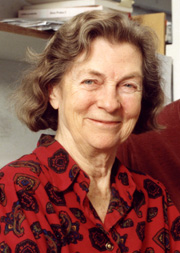Professor Dame Anne McLaren was an English geneticist who helped to develop the techniques that made in vitro-fertilisation a reality. A diligent scientist, Anne authored over three hundred papers and several books, and was recognised as a world-leading expert and ethical advisor in her field.
Anne achieved her PhD in zoology in 1952 on the subject of neurotropic viruses. After graduating from Oxford University, she proceeded on to University College London, where with her partner Donald Michie she began fundamental research into environmental effects upon the skeletal development of rodents.
Her earlier work paved the way for her interest in the techniques of embryo transfer, and it was during the pair’s later appointment within the Royal Veterinary College that Anne teamed up with John Biggers to achieve the first successful birth of a mouse from an embryo cultivated outside of the mother’s body. A groundbreaking success, this achievement set the stage for the world’s first IVF-conceived human in 1978, and the subsequent treatments of infertility that to this day have helped millions to conceive worldwide.
After Anne and Donald separated in 1959, she continued her work within Edinburgh’s Institute of Animal Genetics, where she specialized in mammalian fertility and techniques for embryonic transfer. It was here that Anne undertook significant research in the development and cell lineage of mammalian chimaeras (i.e. organisms originating from two distinct zygotes, and thus consisting of two or more genetically different kinds of tissue) and was soon recognised as an international expert on the subject. Her book Mammalian Chimaeras is regarded as a classic in the field.
After fifteen years in Edinburgh, Anne was appointed director of the Medical Research Council Mammalian Development Unit, returning again to University College London. In her 18 years in the Unit, she sustained a keen interest in the differentiation of germ cells in mammals, with the dream of innovating tools that would allow scientists to counteract cellular damage (such as through disease or injury) via the use of stem cell treatments.
Anne was deeply involved in ethical and legal discussions surrounding genetic research, and as a member of the Warnock Committee played an integral part in the passing of the UK Human Fertilisation and Embryology Act, to regulate and advise upon embryo research. In 1975, Anne was made a fellow of the Royal Society, becoming the first woman within the Society to serve there as an officer, followed by foreign secretary, and then vice president. Among many other awards, Anne was appointed a DBE in 1993 for her services to scientific advancement.
In 2007, Anne and Donald (who remained on good terms throughout their lives) sadly died in a car accident, and are remembered widely as two exceptional scientific minds missed by many. The University of Nottingham’s Anne McLaren fellowship, targeting outstanding early career female researchers in STEM subjects, is named in her honour.
see [1][2][3][4]


As a 15 year old, I started working for DRs Michie and Mclaren in 1957 at the Royal Vetinary College London, and was junior laoratory assistant during their experiments in transfer of fertilised egg cells and culture of embryos outside the uterus..I only stayed with them for one year due to the impending move to Edinburgh,but would never have left had they stayed in LOndon